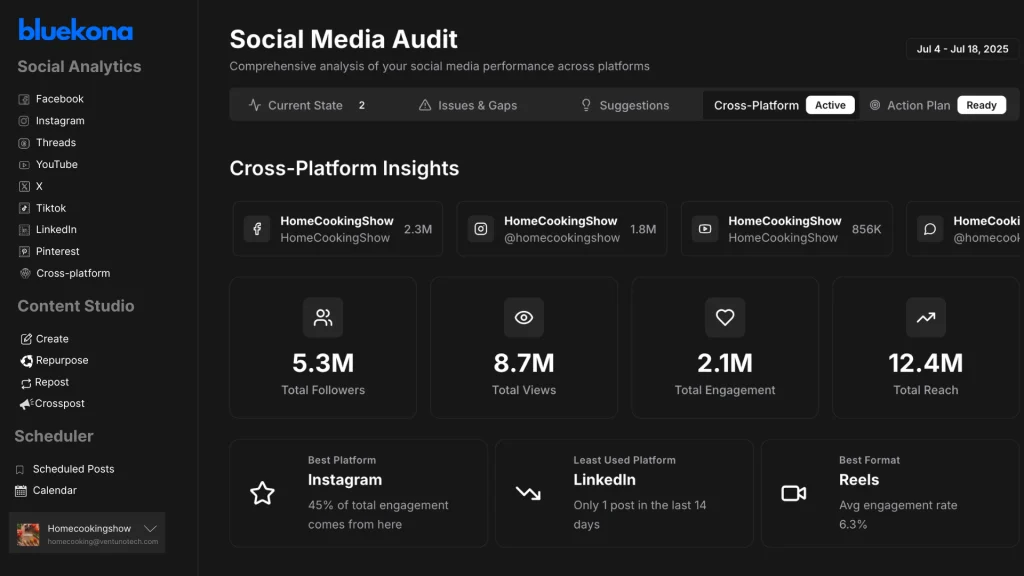
Most brands repurpose content. But almost none can prove if it’s worth it.
Sure, you can track likes, clicks, or views. But when one podcast becomes a LinkedIn post, a YouTube short, an email snippet, and a blog quote — which one actually delivered value?
Without a clear view of repurposed content ROI, brands overcommit to content that flops and underuse what performs.
This is where AI changes everything.
Bluekona’s Social Media Audit connects the dots across channels, formats, and timelines, revealing how each repurposed asset contributes to real business outcomes. Engagement. Traffic. Leads. ROI.
Let’s break down why measuring repurposing ROI is so hard — and how Bluekona makes it automatic.
Repurposing content sounds efficient in theory — but in practice, it’s often where marketing data goes to die.
The result? Teams double down on content that looks good in isolation but delivers little ROI.
Meanwhile, high-performing repurposed assets go unnoticed or get used once and forgotten.
The biggest problem isn’t creating more content — it’s not knowing which content is actually worth creating again.
Most content teams track surface-level metrics — likes, views, maybe CTR. But repurposing ROI goes deeper. To make smart decisions about what to keep creating (and what to stop), you need to measure impact holistically.
Measuring ROI isn’t just about likes. It’s about efficiency and impact — across every repurposed asset.

How did each version of your content perform — not just in aggregate, but per channel?
A LinkedIn snippet may drive comments, while the same clip on Instagram gets ignored. You need to know what works where, not just that something worked.
Repurposing is supposed to be efficient — but is it?
ROI should weigh how much time and effort was saved versus how much additional reach or engagement was actually earned. Did the five social edits justify the edit hours?
Which repurposed pieces are pulling their weight in real business terms?
ROI means tracking back to outcomes — clicks, form fills, subscribers, pipeline. Not every post will convert, but patterns reveal which formats move people forward.
How many times did an asset get reused — and how did performance hold up? Some formats degrade after the first post.
Others get stronger with iteration. ROI measurement should help you identify when to repurpose again, reformat, or retire.
With this level of visibility, you’re not just tracking content but you’re also optimizing your entire repurposing strategy for efficiency and impact.
To get real visibility into repurposed content performance, teams need more than scattered analytics. The process should be automated, connected, and insight-driven. Here’s what an effective solution looks like
Bluekona gives you full visibility into how your repurposed content performs.
Each feature is designed to solve a specific pain point and help you make smarter, faster decisions about what to reuse, reformat, or retire.
Manually connecting performance across channels is messy and time-consuming.
Bluekona automatically links every version of a content piece, whether it’s original posts, repurposed formats, or cross-posts, so you can measure their performance together or separately, all in one place.
The AI clusters similar content types, like quote cards or short-form reels, and then ties them to actual results.
It maps each group to key metrics like engagement, lead generation, and click-through rates.
Tracking repurposed content over time is nearly impossible without a system.
Bluekona gives you a timeline view that shows how a single idea performs across platforms and over weeks or months. This makes you see momentum, fatigue, or missed opportunities.
Performance isn’t just about views. To measure impact, content should be evaluated on what it actually drives — clicks, form fills, new followers.
Ideally, each asset should carry an engagement score that factors in all of its appearances, even across different platforms.
Deciding what to repurpose again shouldn’t be a guessing game.
Bluekona analyzes performance patterns and gives clear guidance on whether to republish, reformat, or retire each asset based on data.
This lets your team focus time and budget on what’s proven to work.
A well-executed repurposing strategy isn’t just about content output. It’s about visibility into what’s working, where, and why.
Dashboards like this one provide a centralized view of cross-platform performance so you can stop guessing and start optimizing.

Here is what to look for in the dashboard
The dashboard pulls in metrics from each social channel — including views, engagement, and reach.
This allows you to compare performance side by side. No more toggling between apps or exporting CSVs.
Core metrics like Total Followers, Views, Engagement, and Reach are displayed across all platforms. This makes it easy to measure the full return on marketing efforts, even when it’s scattered into different channels.
In this example, Reels are identified as the best-performing format with a 6.3% average engagement rate.
Knowing which format consistently drives ROI helps you decide where to focus future repurposing efforts.
While Instagram drives nearly half of the total engagement, LinkedIn has seen almost no recent activity.
This type of insight helps justify reallocating team time — or testing underused platforms with proven content.
Insight in action: Repost high-performing Instagram content to LinkedIn to fill engagement gaps.
This kind of visual breakdown gives your team the clarity to stop guessing, start tracking, and make every repurposed asset count.
It’s not enough to know how your content performed — you need to act on it. ROI insights like these turn your repurposing efforts into a high-efficiency growth strategy.
If certain formats consistently underperform, stop investing time in them.
Low-engagement Stories, static posts with no clicks, or platforms with zero traction — this is where effort gets lost. Let the data make those calls for you.
Use ROI insights to identify high-performing formats and platforms, then scale them.
If Instagram Reels drive the most engagement, views, or leads, make that your core repurposing focus. Invest more in what’s proven to deliver results.
Go beyond vanity metrics. Use hard data to measure impact of your team’s work — how much reach, engagement, and lead potential each repurposed asset is generating.
You’re not just making content — you’re building a system that multiplies returns.
This is the kind of insight that turns content strategy from a creative function into a measurable, defendable business asset.
Book a free social media ROI audit and get a clear view of how your repurposed content is performing across every platform.
Stop guessing. Start measuring what matters.
Let BlueKona show you how every piece of content pays off — or doesn’t.

Nov 7, 2025Anjana Devi
While most beverage brands were burning millions on Super Bowl ads and celebrity endorsements, Prime skipped the playbook. KSI and Logan Paul built something else entirely: a content machine that turned every drop into a cultural event, every meme into distribution fuel, and every sip into social currency. No traditional ad budgets. No media buys. […]

Oct 31, 2025Anjana Devi
The landscape of TikTok has shifted dramatically and brands that are paying attention are reaping the rewards. What used to be all about viral dances and comedy sketches has quietly transformed into something much more impactful — Gen Z’s favorite search engine for finding products, tutorials, and recommendations. With a staggering 1.59 billion potential ad […]

Oct 24, 2025Anjana Devi
Back in 2014, dating apps felt like a never-ending cycle of swipe fatigue and shallow matches. Tinder was the king of the hill, and Match Group had the cash to back it up. But what they did not have? A brand that women could genuinely trust. The Differentiator: Women First Back in 2014, most dating […]